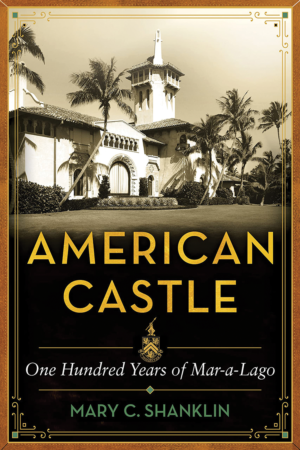If those walls could talk.
If only the floors could say who walked across them, carrying towels, suitcases, or boxes. Would the doors say who slammed them, or why? Could the windows tell who peered from their glassy sides? If the walls of a building could talk – say, the ones in “American Castle” by Mary C. Shanklin – imagine the issues that could be put to rest.
In a way, it all began with the Spanish flu.
Had Blanche Hutton not caught it and died, her husband, investment banker “E.F.” wouldn’t have been widowed. Had she lived, Hutton wouldn’t have had a chance to be captivated by the lovely cereal heiress, Marjorie Merriweather Post on Valentine’s Day evening, 1920.
Imagine it: two extremely wealthy, unmarried people at a soiree on a luxury houseboat near Palm Beach. He’d come to Florida to taste what an up-and-coming elite playground had to offer. She was there, says Shanklin, for a fun after-divorce romance.
So one thing led to another, and the two were wed. They honeymooned in the Adirondacks, then settled into several luxury homes in several tony locales. The new Mrs. Hutton was particularly captivated, not by the “small” Palm Beach home her husband loved best, but by the one she had started constructing. Marjorie spent millions on the mansion she called Mar-a-Lago, Spanish for “sea to lake.”
Alas, after awhile, the Hutton marriage was doomed to fail.
The settlement was generous to Marjorie, who got her Mar-a-Lago, among other homes – but the bloom was off the rose and she all but abandoned her mansion, in favor of other interests. Determined that Mar-a-Lago be preserved, she tried to donate it to the U.S. government in the 1960s but while it was accepted in last-minute paperwork by one Presidential administration, it was unlisted by another. The mansion that cereal built went up for sale again and again and it sat, barely used, until a New York real estate mogul finally purchased it in 1985…
Reading “American Castle” is like having a tabloid newspaper in front of you and a history book on the side. Or the other way around. Or both; straddling many important historical events, there’s enough inside here to satisfy the two genres equally.
Author Mary C. Shanklin writes of the scandalous behavior of the rich and famous of a century ago in a faux-offended way that pokes gentle fun and brings to mind Grandma and a lot of pearl-clutching. And yet, the long tale of a big house is a serious one that oozes with real money, lavish privilege, government bureaucracy, and the aura of a white elephant. That Mar-a-Lago’s now and forever connected in a firm way to politics, accusations. and indictments is the part you gotta read, even if you think you know what Shanklin has to offer.
You want the rest of the story, you got it here, so don’t miss it. If you love the history of privilege, politics, or current events, “American Castle” is a book you won’t stop talking about.
“American Castle: One Hundred Years of Mar-a-Lago” by Mary C. Shanklin
c.2023, Diversion Books
$29.99
304 pages




